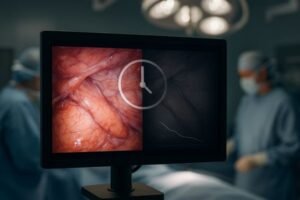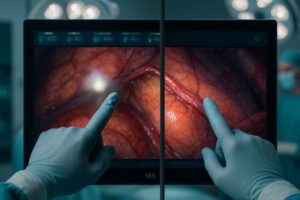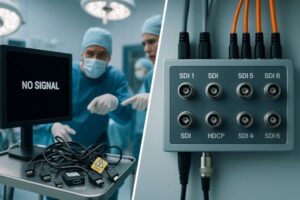Clean room operating rooms demand meticulous attention to sterility and workflow. Traditional equipment setups can create clutter. I understand that optimizing the OR environment is key for surgical success and patient safety.
Yes, wall-mounted displays are highly effective in clean room ORs. They minimize floor clutter, enhance sterility by reducing touchpoints and simplifying cleaning, and can improve surgical team efficiency when correctly positioned.
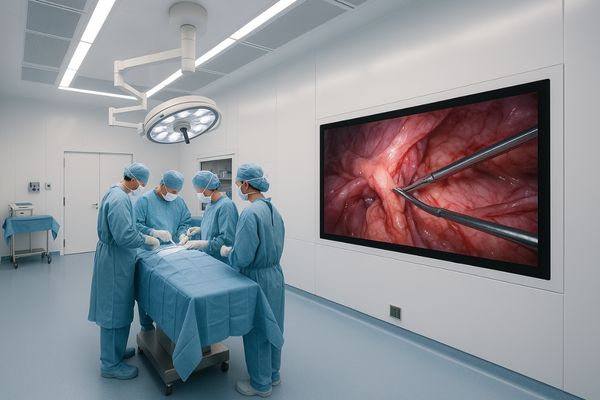
The design of a modern operating room, especially a clean room environment, prioritizes sterility, efficiency, and safety. Every piece of equipment must contribute to these goals. Wall-mounted surgical displays have emerged as a popular solution for visualizing critical patient information and surgical imaging. Their placement can significantly impact the overall functionality of the OR. I will explore the various facets of using wall-mounted displays in these specialized settings. This discussion will cover their advantages, implications for infection control1, effects on team efficiency2, potential limitations, and how display manufacturers are optimizing their products for such integrations. Careful consideration of these factors helps ensure the OR is truly optimized.
What are the advantages of wall-mounted displays in sterile environments?
Sterile environments are compromised by clutter and hard-to-clean equipment. Floor-standing or cart-based displays can obstruct movement. They also create more surfaces for contaminants to settle, complicating cleaning protocols.
Wall-mounted displays offer significant advantages in sterile environments by keeping floor areas clear, reducing physical obstructions and touch points, and simplifying cleaning processes. This inherently supports laminar airflow integrity and makes maintaining sterility easier.
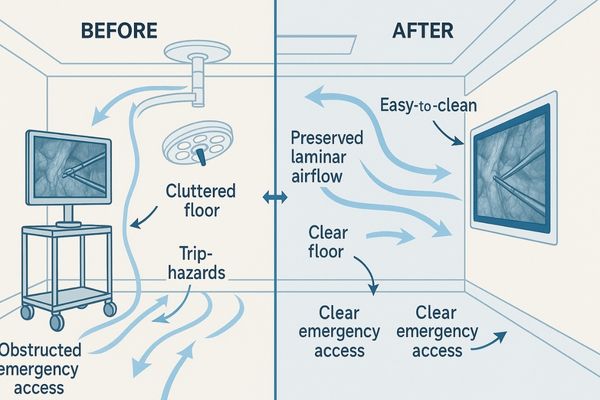
The adoption of wall-mounted displays3 in sterile operating environments, particularly clean rooms, brings several compelling benefits. One of the most immediate advantages is the maximization of floor space. By moving displays from mobile carts or boom arms to the walls, the floor area remains unobstructed. This is crucial for facilitating smooth movement of the surgical team and essential mobile equipment. It also significantly reduces tripping hazards. Fewer items on the floor mean fewer surfaces to accumulate dust and contaminants, which directly contributes to easier and more effective cleaning routines. This aspect is vital for maintaining the stringent sterility levels required in clean rooms4. Wall-mounted displays also help preserve the integrity of laminar airflow systems, which are often employed in clean room ORs to minimize airborne particles over the surgical site. Equipment on the floor can disrupt these carefully controlled air currents. The MD33G – 3MP Grayscale Diagnostic Monitor, while a diagnostic display, exemplifies design principles like sealed casings and smooth surfaces that are beneficial for any equipment intended for hygienically sensitive areas, including areas adjacent to or supporting clean room ORs where images might be reviewed. Furthermore, reducing the number of "touch points" in the room contributes to better infection control5, as there are fewer surfaces that require constant disinfection from frequent handling.
Comparing Display Mounting Options in Clean Room ORs
The choice of display mounting significantly impacts the functionality and sterility of a clean room OR. Each option has its own set of characteristics.
| Mounting Option | Floor Space Impact | Cleaning Ease | Laminar Airflow Interference | Cable Management | Flexibility/Adjustability |
|---|---|---|---|---|---|
| Wall-Mounted | Minimal/None | High | Minimal | Often Integrated | Moderate (can be fixed) |
| Ceiling Boom-Arm | Minimal/None | Moderate | Low to Moderate | Integrated | High |
| Mobile Cart | High | Low | High | External | High |
This comparison highlights that while boom arms offer high flexibility, wall-mounted displays often provide the best balance for maintaining floor clearance and ease of cleaning, critical for sterile environments.
Do wall-mounted monitors support infection control protocols?
Infection control is paramount in any OR, but especially in clean rooms. Equipment design can either hinder or help these crucial protocols. Monitors with crevices or exposed cables can become reservoirs for pathogens.
Yes, well-designed wall-mounted monitors actively support infection control protocols. Their typical features include seamless, sealed enclosures, integrated cable management that minimizes dust accumulation and fluid ingress, and surfaces that withstand rigorous hospital-grade disinfectants.
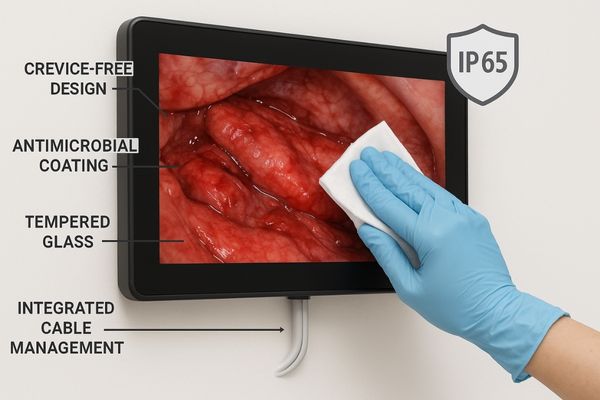
Wall-mounted monitors can be significant assets in upholding strict infection control standards within the operating room. A key design aspect that contributes to this is the ability to fully seal the display unit. High-quality medical-grade wall-mounted displays often feature IP (Ingress Protection) rated enclosures6. This rating signifies their resistance to the penetration of dust and liquids, which is essential when displays are subjected to frequent cleaning and disinfection, sometimes involving sprays or wipes with potent chemical agents. The surfaces are typically smooth and non-porous, often made from materials like medical-grade polymers7 or tempered glass. These characteristics prevent microbes from harboring in tiny crevices and make the surfaces easy to wipe down thoroughly. Cable management is another important consideration. Wall-mounted systems allow for cables to be routed directly into the wall or through concealed conduits. This drastically reduces the number of exposed wires that can accumulate dust or become contaminated. Our MS220S – 22" FHD Endoscopic Monitor is designed with hygiene in mind, featuring smooth surfaces that facilitate easy cleaning, a principle we extend to units suitable for wall integration. When monitors are integrated flush into a wall, it further minimizes ledges or surfaces where contaminants could settle, creating an even more hygienically sound environment. This makes them an excellent choice for environments where minimizing HAIs (Hospital Acquired Infections)8 is a top priority.
Key Design Features for Infection Control in Wall-Mounted Displays
Several specific design elements are crucial for ensuring wall-mounted displays meet the demanding infection control requirements of modern ORs.
| Feature | Infection Control Benefit |
|---|---|
| Sealed, Crevice-Free Enclosure | Prevents ingress of fluids and particulate matter; no harborages for microbes. |
| High IP Rating (e.g., IP65 front) | Indicates strong protection against dust and water/cleaning fluid splashes. |
| Smooth, Non-Porous Surfaces | Easy to wipe clean and disinfect effectively; resists microbial adhesion. |
| Chemically Resistant Materials | Withstands repeated cleaning with harsh hospital-grade disinfectants without degradation. |
| Integrated Cable Management | Minimizes exposed cables that can trap dust and contaminants. |
| Antimicrobial Coatings (Optional) | Provides an additional layer of active microbial growth inhibition on surfaces. |
| Fanless Design (where feasible) | Reduces circulation of airborne particles within the display’s vicinity. |
These features work synergistically to ensure that wall-mounted displays contribute positively to the overall cleanliness and safety of the surgical environment.
How does mounting position impact surgical team efficiency?
The placement of a surgical display is not just about saving space. It directly influences how effectively the surgical team can work. Poor positioning can lead to strain, delays, and even compromised focus.
Proper mounting position for wall displays significantly enhances surgical team efficiency. When aligned with the natural eye level and line of sight for key personnel, it reduces neck strain, minimizes the need for frequent physical readjustments, and improves focus by providing clear, immediate access to real-time imaging.
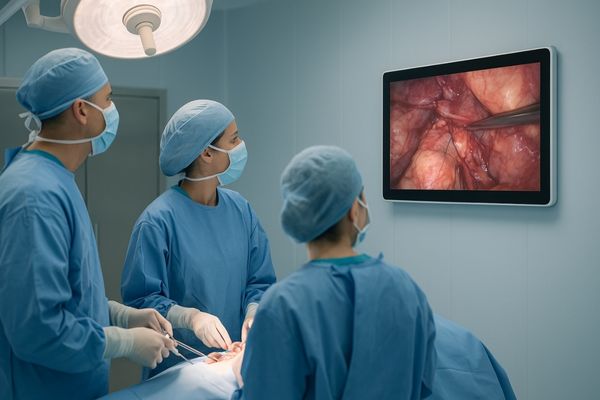
The strategic positioning of wall-mounted displays9 in an operating room is critical for optimizing the surgical team’s workflow10 and overall efficiency. When a display is mounted at the correct height and angle relative to the primary users—typically the surgeon and assisting staff—it allows for comfortable viewing without requiring awkward postures. This ergonomic placement11 helps to reduce physical strain, particularly on the neck and shoulders, which can accumulate over long procedures and lead to fatigue and reduced concentration. A well-positioned display ensures that vital information, such as endoscopic views, patient vitals, or radiological images, is within the team’s direct line of sight. This minimizes the need for them to turn their heads excessively or shift their gaze far from the surgical field, thereby allowing for better focus on the task at hand. The MD45C – Dual-screen Diagnostic Monitor (Single Panel), though a diagnostic tool, demonstrates the value of presenting comprehensive information clearly; in an OR, a well-placed wall display serves a similar purpose for intraoperative data. Quick, easy access to visual information translates into faster decision-making and smoother coordination among team members. In ORs designed for specific types of procedures, wall displays can be pre-set to optimal viewing locations, further streamlining the setup process and ensuring consistent viewing conditions for recurrent operations. Thoughtful placement also considers the movement patterns within the OR, ensuring that displays do not obstruct pathways or interfere with other essential equipment.
Are there limitations in flexibility or visibility with fixed displays?
Wall-mounting offers many benefits, especially for sterility and space. However, once a display is fixed to a wall, its position is set. This might seem restrictive compared to more mobile options.
Yes, fixed wall-mounted displays inherently have limitations in adjustability compared to boom-mounted or cart-based systems. However, these limitations can often be mitigated by pairing them with articulated extension arms, careful pre-planning of viewing zones, or by using multiple displays to cover different vantage points, thereby expanding visibility for the entire surgical team.
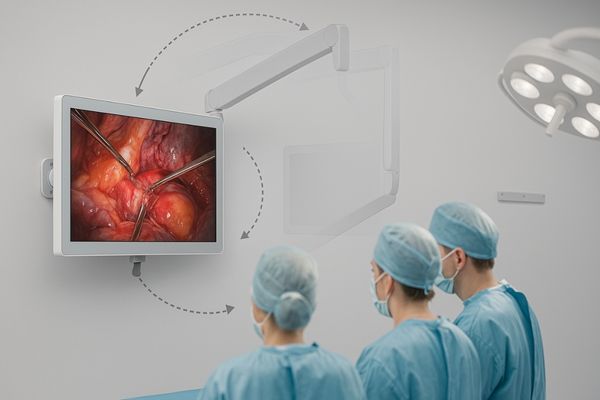
While wall-mounted displays offer distinct advantages in terms of space-saving and cleanliness, their fixed nature does present certain limitations regarding flexibility and visibility. Unlike displays on mobile carts or articulated boom arms, a directly wall-mounted screen cannot be easily repositioned during a procedure to accommodate changes in surgeon stance, patient positioning, or the specific needs of different team members. This lack of dynamic adjustability can be a drawback in complex surgeries where viewing angles may need to vary. Visibility can also be a concern if a single fixed display is expected to serve an entire surgical team12, as members positioned further away or at oblique angles may not have an optimal view. However, these limitations are not insurmountable. One common solution is to mount the display on an articulated wall arm13. This provides a degree of horizontal and vertical movement, as well as tilt and swivel capabilities, offering a compromise between the stability of wall mounting and the adjustability of a boom. Our MS247SA – 24" FHD Endoscopic Monitor, being a more compact unit, could be effectively paired with such an arm for enhanced positioning. Another strategy involves careful OR planning14, where fixed displays are strategically placed in pre-determined optimal viewing zones based on common surgical setups. In larger ORs or for procedures requiring multiple information streams, installing more than one wall-mounted display at different locations can ensure that all team members have adequate visual access.
How does Reshin optimize its monitors for wall integration in ORs?
Integrating displays into an OR wall is more than just attaching them. It requires specific design features to ensure hygiene, safety, and optimal performance. The display must become a seamless part of the clean room environment.
Reshin optimizes its monitors for wall integration by incorporating features like flat, easy-to-clean tempered glass fronts, IPX-rated protection against fluid ingress, slim bezel designs for near-seamless embedding, and robust construction suitable for the OR environment. This ensures hygiene, antimicrobial safety, and excellent visibility.
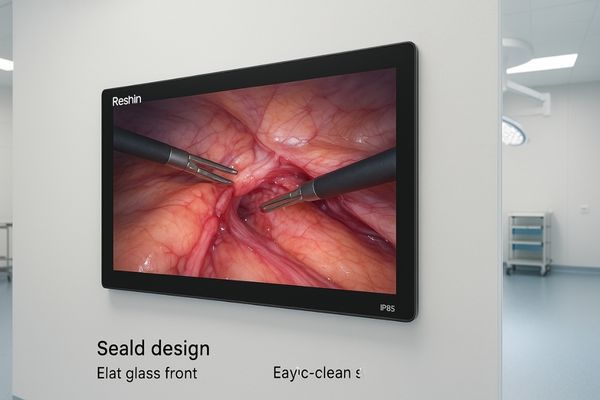
At Reshin, we understand that effective wall integration in operating rooms, especially clean rooms, demands more than just standard VESA mounting compatibility. Our surgical monitors15 are engineered with specific characteristics to meet these demanding requirements. A key feature is the use of flat, edge-to-edge tempered glass on the front surface. This not only provides excellent durability and impact resistance but also creates a completely smooth, crevice-free surface that is exceptionally easy to clean and disinfect thoroughly, which is paramount for infection control16. Many of our models intended for OR use, such as the MS321PB – 32" 4K Surgical Monitor, feature high IP ratings17 (e.g., IP65 on the front panel). This signifies robust protection against dust and fluid ingress, ensuring the monitor can withstand the rigorous cleaning protocols common in surgical environments without compromising its internal electronics. Slim bezel designs are another important optimization. Thinner bezels allow for a more aesthetically pleasing and near-seamless integration when the monitor is embedded into a wall or console, minimizing gaps where dust or contaminants could potentially accumulate. Furthermore, we focus on robust overall construction using medical-grade materials that are resistant to common hospital disinfectants. Our designs also consider heat dissipation for enclosed installations and ensure easy access for any necessary maintenance, while prioritizing long-term reliability to minimize disruptions in the critical OR setting. These design considerations ensure our monitors are not just mounted, but truly integrated for optimal performance, hygiene, and safety.
Conclusion
Wall-mounted displays offer significant benefits for clean room ORs. They enhance sterility, improve workflow, and save space when thoughtfully selected and correctly integrated into the surgical environment. To implement space-saving, hygienic wall-mounted displays, contact Reshin at martin@reshinmonitors.com.
-
Learn about the role of technology in maintaining sterility and preventing infections in surgical environments. ↩
-
Discover how visual aids can streamline communication and improve workflow among surgical teams. ↩
-
Explore how wall-mounted displays enhance space efficiency and safety in sterile environments, crucial for surgical teams. ↩
-
Learn about effective strategies for maintaining sterility in clean rooms, essential for healthcare settings. ↩
-
Discover the importance of minimizing touch points for better infection control, vital for patient safety. ↩
-
Understanding IP ratings can help ensure the right equipment is chosen for infection control in medical settings. ↩
-
Exploring medical-grade polymers reveals their crucial role in creating safe and hygienic medical devices. ↩
-
Learning about HAIs and prevention strategies is vital for improving patient safety and care quality. ↩
-
Explore how wall-mounted displays enhance surgical efficiency and team workflow in operating rooms. ↩
-
Discover effective strategies to optimize workflow and enhance efficiency in surgical settings. ↩
-
Learn about the importance of ergonomic placement in reducing strain and improving focus during surgeries. ↩
-
Learn about the importance of display positioning for surgical teams to ensure everyone has a clear view, enhancing surgical outcomes. ↩
-
Explore how articulated wall arms enhance flexibility and visibility for surgical displays, improving team collaboration and efficiency. ↩
-
Discover effective OR planning strategies that maximize display utility and improve surgical workflow and visibility. ↩
-
Explore this link to discover top-rated surgical monitors that enhance performance and hygiene in operating rooms. ↩
-
Learn about infection control practices in operating rooms to understand the importance of hygiene and safety in surgical environments. ↩
-
Understanding IP ratings can help you choose devices that are resistant to dust and water, crucial for medical environments. ↩

